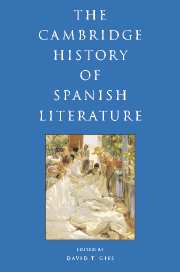Book contents
- Frontmatter
- I INTRODUCTION
- II HISTORY AND CANONICITY
- III THE MEDIEVAL PERIOD
- IV EARLY MODERN SPAIN: RENAISSANCE AND BAROQUE
- V THE ENLIGHTENMENT AND NEOCLASSICISM
- VI THE FORGING OF A NATION: THE NINETEENTH CENTURY
- 22 Romanticism in Spain
- 23 The theatre in Romantic Spain
- 24 Mariano José de Larra
- 25 Romantic poetry
- 26 Romantic prose, journalism, and costumbrismo
- 27 Benito Pérez Galdós
- 28 The Realist novel
- 29 The Naturalist novel
- 30 The theatre in Spain 1850–1900
- 31 Poetry in the second half of the nineteenth century
- VII THE MODERN, MODERNISMO, AND THE TURN OF THE CENTURY
- VIII TWENTIETH-CENTURY SPAIN AND THE CIVIL WAR
- IX IN AND OUT OF FRANCO SPAIN
- X POST-FRANCO SPANISH LITERATURE AND FILM
- Bibliography
- Index
- References
27 - Benito Pérez Galdós
from VI - THE FORGING OF A NATION: THE NINETEENTH CENTURY
Published online by Cambridge University Press: 28 March 2008
- Frontmatter
- I INTRODUCTION
- II HISTORY AND CANONICITY
- III THE MEDIEVAL PERIOD
- IV EARLY MODERN SPAIN: RENAISSANCE AND BAROQUE
- V THE ENLIGHTENMENT AND NEOCLASSICISM
- VI THE FORGING OF A NATION: THE NINETEENTH CENTURY
- 22 Romanticism in Spain
- 23 The theatre in Romantic Spain
- 24 Mariano José de Larra
- 25 Romantic poetry
- 26 Romantic prose, journalism, and costumbrismo
- 27 Benito Pérez Galdós
- 28 The Realist novel
- 29 The Naturalist novel
- 30 The theatre in Spain 1850–1900
- 31 Poetry in the second half of the nineteenth century
- VII THE MODERN, MODERNISMO, AND THE TURN OF THE CENTURY
- VIII TWENTIETH-CENTURY SPAIN AND THE CIVIL WAR
- IX IN AND OUT OF FRANCO SPAIN
- X POST-FRANCO SPANISH LITERATURE AND FILM
- Bibliography
- Index
- References
Summary
The term “Realism,” whether applied to painting, philosophy, literature, or even to what today is called “the real reality TV,” always implies a fundamental duality. There is, on the one hand, the perception of a world of things that simply exists – “inanimate, spatially extended, and subject to quantifiable forces” – and, on the other, there is the mind –“the seat of thought, understanding, sensation, and imagination.” The mind–body dualism of Descartes (1596–1650) and the inventions and discoveries of Galileo (1564–1642) had shaped for Western civilization the scientific worldview. This view delineated three basic intellectual positions vis-à-vis the relationship between mind and world: skepticism, or the idea that what the mind pictures or imagines cannot be a reliable guide to knowledge; idealism, or the conviction that a sensorial and subjective understanding, including certain belief systems, is the only one there is; and Realism, or the perspective that “heroically bridges the gap”.
During the nineteenth century, in Spain as in the rest of Europe, the task of bridging this gap, ever widening under the impact of political and social changes as well as scientific discoveries, technological inventions, and industrial advances, became the heroic project of Benito Pérez Galdós (1843–1920), Spain’s preeminent Realist novelist. He sought to depict the impact of current political, social, and economic factors that jaggedly shaped everyday life: the resurgence of national consciousness and the imperatives of democracy in forming a nation; the rising presence and power of the bourgeoisie, of industrial growth, and the emergence of an exploited laboring class; the rise of banking, the stock market, the invention of institutional systems of credit and debit, and the introduction of paper money; the opening of railway lines, the spread of gas lighting, the construction of roads and waterways; improved sanitation, a developing interest in public and private health, together with the advances of medicine – anesthesia (1840s), germ theory (1847), antisepsis (1867), vaccination (1876), asepsis (1883), and radiology (1895).
- Type
- Chapter
- Information
- The Cambridge History of Spanish Literature , pp. 392 - 409Publisher: Cambridge University PressPrint publication year: 2005



